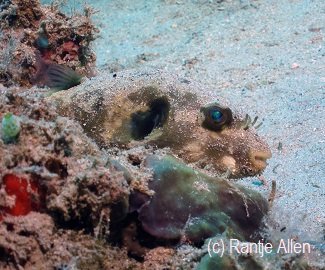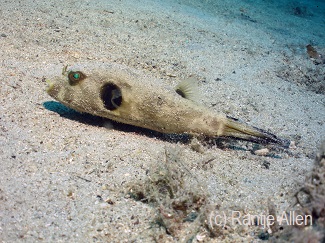Loading content - please wait...
Arothron immaculatus Emerges from Hiding
Arothron immaculatus or the Immaculate puffer is rarely seen in coral dense environments typical of Gorontalo. But one day it make a surprise appearance.
Hiding on a Sandy Bottom

One day a dive master from Miguel’s Diving spotted the bright yellow eye of a fish trying to hiding itself in the white sand bottom. By the way, one of the common names for Arothron immaculatus is Yellow-eyed puffer. Knowing it had been seen, the fish tried to flick more sand over its oval-shaped body. However, its brilliant eyes and strange tufts on top its nose remained clearly visible. It shifted around closer to a mass of corals, revealing a mottled pattern as the grains of white sand began to fall off its body. After posing for a few photos, the fish decided to flee across the white sand bottom. It even and pale color could help it hide undetected there.
Arothron immaculatus around the Pacific
This Immaculate puffer can be found through Indo-Pacific waters. It clearly prefers sandy or silty bottoms near coral reefs or shallow estuaries. The Arothron immaculatus seen in Gorontalo was living at one of our alternate muck diving sites. The site is called Mystic Point. It is close to the estuary of Bone River. That dive site is known for its relatively poor coral but has a white sand bottom that is rare for our area of Gorontalo. That site has marine life only found there, like the Twin-eyed goby and the Immaculate puffer. This puffer can also be found near mangroves and seagrass beds. Western Gorontalo has those environments, so perhaps this puffer can also be found there.
This puffer is usually solitary and rarely in large numbers in its environments. It is found between three and thirty meters. It is mostly carnivorous.

Arothron immaculatus has some distinctive markings that help confirm its identity. Apart from its beautiful eyes and nose tufts
, its body is basically plain, unless it is sporting the botches of its camouflaged mode. Moreover, it has a large dark patch around its pectoral fin base. Also, it has dark upper and lower margins on its tail fin. A similar species is Arothron manilensis. However, the Manila puffer has distinct thin lines on its body.The Quixotic and Toxic Puffer
Puffer fish have quite distinctive bodies. This includes tough skin and a dental plate in their beak-like mouth. What they lack is more notable. They lack fin spines and ribs. As a result, they can inflate their stomachs with water when afraid. Moreover, their skin, gonads and liver contain two toxins. These are tetrodotoxin and saxitoxin. Some species are more toxic than others. Because different puffer species have similar body shapes, identification is most accurate when using color patterns.
For your chance to see one of Gorontalo’s puffer fish, please book your dive trip with us.






Sorry, comments are closed for this post.